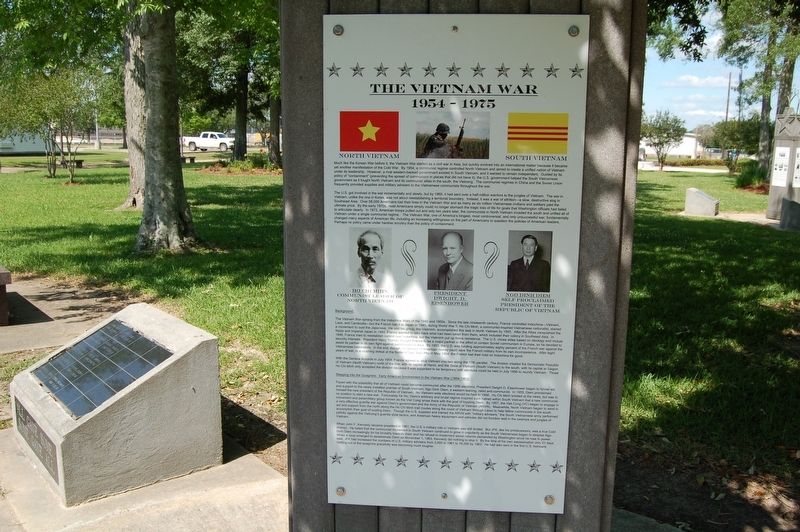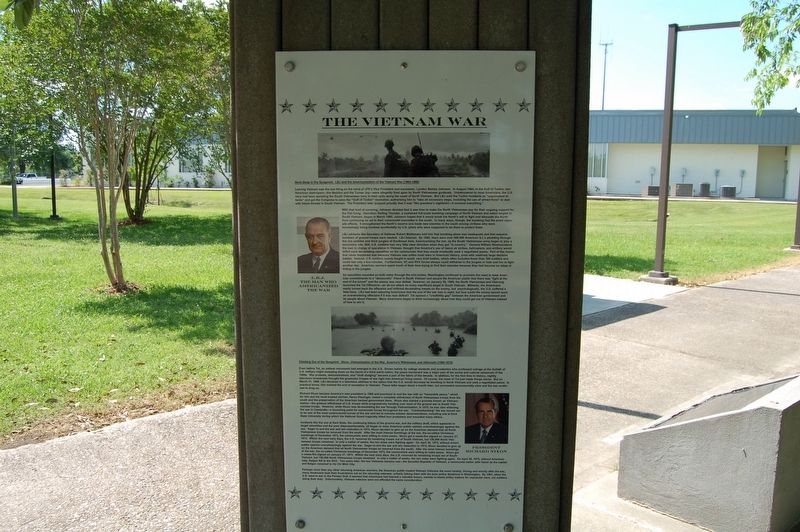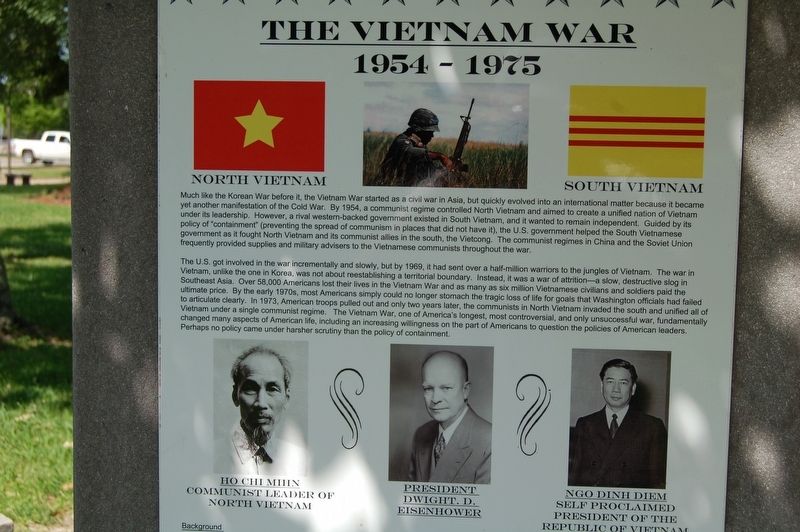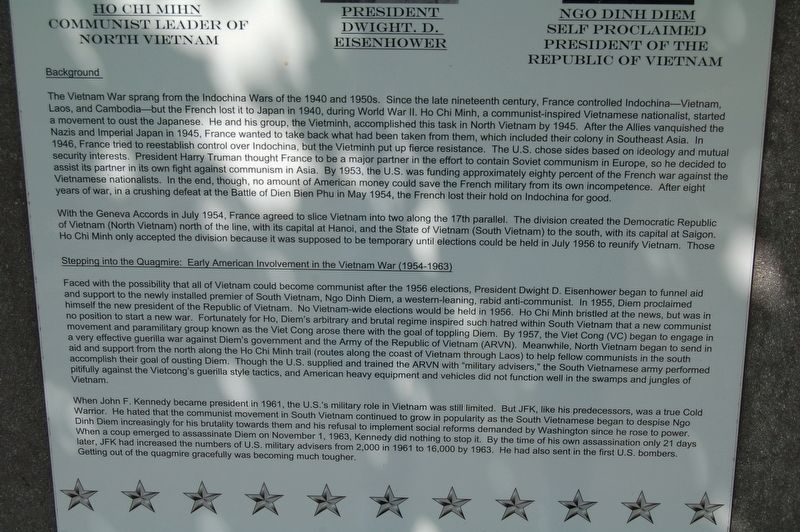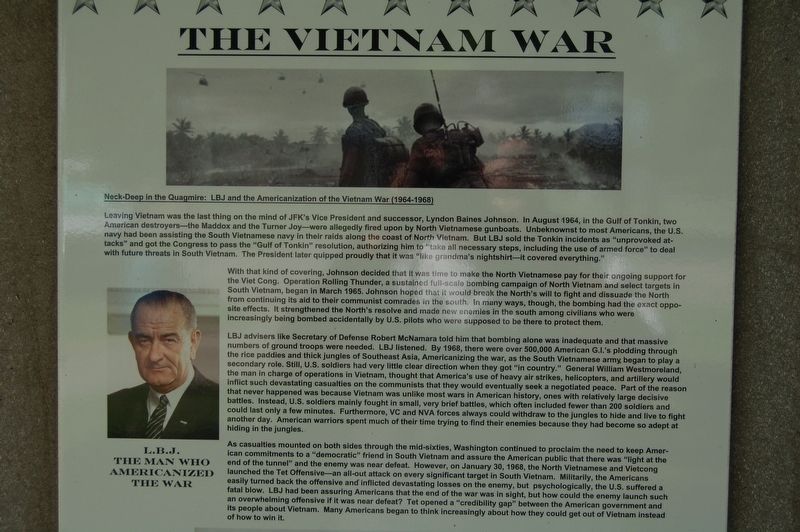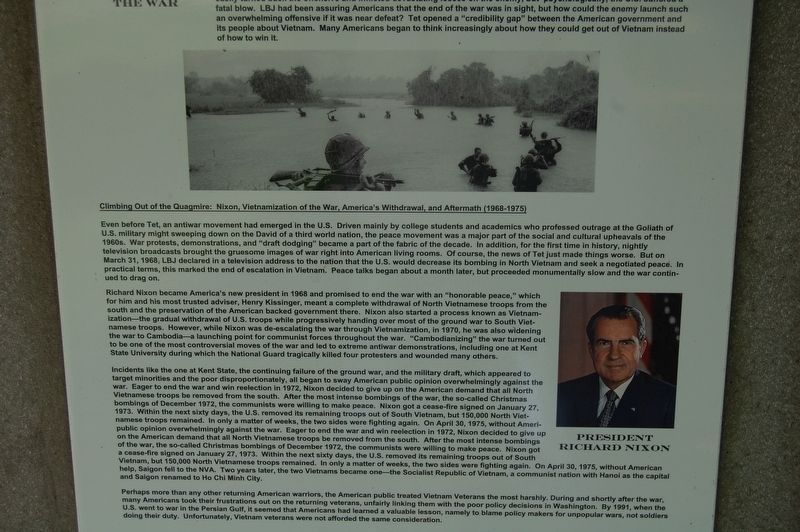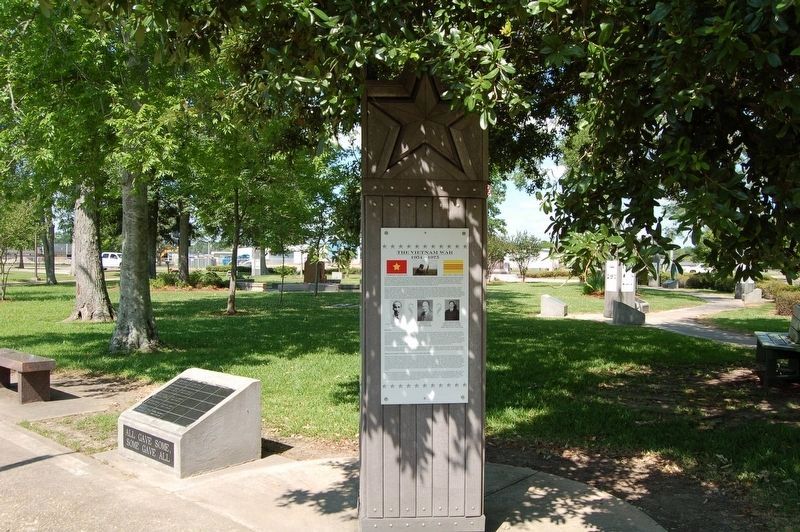Gonzales in Ascension Parish, Louisiana — The American South (West South Central)
The Vietnam War
1954-1975
Much like the Korean War before it, the Vietnam War started as a civil war in Asia, but quickly evolved into an international matter because it became yet another manifestation of the Cold War. By 1954, a communist regime controlled North Vietnam and aimed to create a unified nation of Vietnam under its leadership. However, a rival western-backed government existed in South Vietnam, and it wanted to remain independent. Guided by its policy of "containment" (preventing the spread of communism in places that did not have it), the U.S. government helped the South Vietnamese government as it fought North Vietnam and its communist allies in the south, the Vietcong. The communist regimes in China and the Soviet Union frequently provided supplies and military advisers to the Vietnamese communists throughout the war.
The U.S. got involved in the war incrementally and slowly, but by 1969, it had sent over a half-million warriors to the jungles of Vietnam. The war in Vietnam, unlike the one in Korea, was not about reestablishing a territorial boundary. Instead, it was a war of attrition—a slow, destructive slog in Southeast Asia. Over 58,000 Americans lost their lives in the Vietnam War and as many as six million Vietnamese civilians and soldiers paid the ultimate price. By the early 1970s, most Americans simply could no longer stomach the tragic loss of life for goals that Washington officials had failed to articulate clearly. In 1973, American troops pulled out and only two years later, the communists in North Vietnam invaded the south and unified all of Vietnam under a single communist regime. The Vietnam War, one of America's longest, most controversial, and only unsuccessful war, fundamentally changed many aspects of American life, including an increasing willingness on the part of Americans to question the policies of American leaders. Perhaps no policy came under harsher scrutiny than the policy of containment.
Background
The Vietnam War sprang from the Indochina Wars of the 1940 and 1950s. Since the late nineteenth century, France controlled Indochina-Vietnam, Laos, and Cambodia—but the French lost it to Japan in 1940, during World War II. Ho Chi Minh, a communist-inspired Vietnamese nationalist, started a movement to oust the Japanese. He and his group, the Vietminh, accomplished this task in North Vietnam by 1945. After the Allies vanquished the Nazis and Imperial Japan in 1945, France wanted to take back what had been taken from them, which included their colony in Southeast Asia. In 1946, France tried to reestablish control over Indochina, but the Vietminh put up fierce resistance. The U.S. chose sides based on ideology and mutual security interests. President Harry Truman thought France to be a major partner in the effort to contain Soviet communism in Europe, so he decided to assist its partner in its own fight against communism in Asia. By 1953, the U.S. was funding approximately eighty percent of the French war against the Vietnamese nationalists. In the end, though, no amount of American money could save the French military from its own incompetence. After eight years of war, in a crushing defeat at the Battle of Dien Bien Phu in May 1954, the French lost their hold on Indochina for good.
With the Geneva Accords in July 1954, France agreed to slice Vietnam into two along the 17th parallel. The division created the Democratic Republic of Vietnam (North Vietnam) north of the line, with its capital at Hanoi, and the State of Vietnam (South Vietnam) to the south, with its capital at Saigon. Ho Chi Minh only accepted the division because it was supposed to be temporary until elections could be held in July 1956 to reunify Vietnam.
Stepping into the Quagmire: Early American Involvement in the Vietnam War (1954-1963)
Faced with the possibility that all of Vietnam could become communist after the 1956 elections, President Dwight D. Eisenhower began to funnel aid and support to the newly installed premier of South Vietnam, Ngo Dinh Diem, a western-leaning, rabid anti-communist. In 1955, Diem proclaimed himself the new president of the Republic of Vietnam. No Vietnam-wide elections would be held in 1956. Ho Chi Minh bristled at the news, but was in no position to start a new war. Fortunately for Ho, Diem's arbitrary and brutal regime inspired such hatred within South Vietnam that a new communist movement and paramilitary group known as the Viet Cong arose there with the goal of toppling Diem. By 1957, the Viet Cong (VC) began to engage in a very effective guerrilla war against Diem's government and the Army of the Republic of Vietnam (ARVN). Meanwhile, North Vietnam began to send in aid and support from the north along the Ho Chi Minh trail (routes along the coast of Vietnam through Laos) to help fellow communists in the south accomplish their goal of ousting Diem. Though the U.S. supplied and trained the ARVN with “military advisers,” the South Vietnamese army performed pitifully against the Vietcong's guerrilla style tactics, and American heavy equipment and vehicles did not function well in the swamps and jungles of Vietnam.
When John F. Kennedy became president in 1961, the U.S.'s military role in Vietnam was still limited. But JFK, like his predecessors, was a true Cold Warrior. He hated that the communist movement in South Vietnam continued to grow in popularity as the South Vietnamese began to despise Ngo Dinh Diem increasingly for his brutality towards them and his refusal to implement social reforms demanded by Washington since he rose to power. When a coup emerged to assassinate Diem on November 1, 1963, Kennedy did nothing to stop it. By the time of his own assassination only 21 days later, JFK had increased the numbers of U.S. military advisers from 2,000 in 1961 to 16,000 by 1963. He had also sent in the first U.S. bombers. Getting out of the quagmire gracefully was becoming much tougher.
Deep in the Quagmire: LBJ and the Americanization of the Vietnam War (1964-1968)
Leaving Vietnam was the last thing on the mind of JFK's Vice President and successor, Lyndon Baines Johnson. In August 1964, in the Gulf of Tonkin, two American destroyers—the Maddox and the Turner Joy–were allegedly fired upon by North Vietnamese gunboats. Unbeknownst to most Americans, the U.S. navy had been assisting the South Vietnamese navy in their raids along the coast of North Vietnam. But LBJ sold the Tonkin incidents as “unprovoked attacks" and got the Congress to pass the “Gulf of Tonkin" resolution, authorizing him to take all necessary steps, including the use of armed force" to deal with future threats in South Vietnam. The President later quipped proudly that it was "like grandma's nightshirt—it covered everything."
With that kind of covering, Johnson decided that it was time to make the North Vietnamese pay for their ongoing support for the Viet Cong. Operation Rolling Thunder, a sustained full-scale bombing campaign of North Vietnam and select targets in South Vietnam, began in March 1965. Johnson hoped that it would break the North's will to fight and dissuade the North from continuing its aid to their communist comrades in the south. In many ways, though, the bombing had the exact opposite effects. It strengthened the North's resolve and made new enemies in the south among civilians who were increasingly being bombed accidentally by U.S. pilots who were supposed to be there to protect them.
LBJ advisers like Secretary of Defense Robert McNamara told him that bombing alone was inadequate and that massive numbers of ground troops were needed. LBJ listened. By 1968, there were over 500,000 American G.I.'s plodding through the rice paddies and thick jungles of Southeast Asia, Americanizing the war, as the South Vietnamese army, began to play a secondary role. Still, U.S. soldiers had very little clear direction when they got “in country." General William Westmoreland, the man in charge of operations in Vietnam, thought that America's use of heavy air strikes, helicopters, and artillery would inflict such devastating casualties on the communists that they would eventually seek a negotiated peace. Part of the reason that never happened was because Vietnam was unlike most wars in American history, ones with relatively large decisive battles. Instead, U.S. soldiers mainly fought in small, very brief battles, which often included fewer than 200 soldiers and could last only a few minutes. Furthermore, VC and NVA forces always could withdraw to the jungles to hide and live to fight another day. American warriors spent much of their time trying to find their enemies because they had become so adept at hiding in the jungles.
As casualties mounted on both sides through the mid-sixties, Washington continued to proclaim the need to keep American commitments to a “democratic" friend in South Vietnam and assure the American public that there was “light at the end of the tunnel” and the enemy was near defeat. However, on January 30, 1968, the North Vietnamese and Vietcong launched the Tet Offensive—an all-out attack on every significant target in South Vietnam. Militarily, the Americans easily turned back the offensive and inflicted devastating losses on the enemy, but psychologically, the U.S. suffered a fatal blow. LBJ had been assuring Americans that the end of the war was in sight, but how could the enemy launch such an overwhelming offensive if it was near defeat? Tet opened a “credibility gap" between the American government and its people about Vietnam. Many Americans began to think increasingly about how they could get out of Vietnam instead of how to win it.
Climbing Out of the Quagmire: Nixon, Vietnamization of the War, America's Withdrawal, and Aftermath (1968-1975)
Even before Tet, an antiwar movement had emerged in the U.S. Driven mainly by college students and academics who professed outrage at the Goliath of U.S. military might sweeping down on the David of a third world nation, the peace movement was a major part of the social and cultural upheavals of the 1960s. War protests, demonstrations, and “draft dodging" became a part of the fabric of the decade. In addition, for the first time in history, nightly television broadcasts brought the gruesome images of war right into American living rooms. Of course, the news of Tet just made things worse. But on March 31, 1968, LBJ declared in a television address to the nation that the U.S. would decrease its bombing in North Vietnam and seek a negotiated peace. In practical terms, this marked the end of escalation in Vietnam. Peace talks began about a month later, but proceeded monumentally slow and the war continued to drag on.
Richard Nixon became America's new president in 1968 and promised to end the war with an “honorable peace," which for him and his most trusted adviser, Henry Kissinger, meant a complete withdrawal of North Vietnamese troops from the south and the preservation of the American backed government there. Nixon also started a process known as Vietnamization—the gradual withdrawal of U.S. troops while progressively handing over most of the ground war to South Vietnamese troops. However, while Nixon was deescalating the war through Vietnamization, in 1970, he was also widening the war to Cambodia — a launching point for communist forces throughout the war. “Cambodianizing" the war turned out to be one of the most controversial moves of the war and led to extreme antiwar demonstrations, including one at Kent State University during which the National Guard tragically killed four protesters and wounded many others.
Incidents like the one at Kent State, the continuing failure of the ground war, and the military draft, which appeared to target minorities and the poor disproportionately, all began to sway American public opinion overwhelmingly against the war. Eager to end the war and win reelection in 1972, Nixon decided to give up on the American demand that all North Vietnamese troops be removed from the south. After the most intense bombings of the war, the so-called Christmas bombings of December 1972, the communists were willing to make peace. Nixon got a cease-fire signed on January 27, 1973. Within the next sixty days, the U.S. removed its remaining troops out of South Vietnam, but 150,000 North Vietnamese troops remained. In only a matter of weeks, the two sides were fighting again. On April 30, 1975, without American help, Saigon fell to the NVA. Two years later, the two Vietnams became one — the Socialist Republic of Vietnam, a communist nation with Hanoi as the capital and Saigon renamed to Ho Chi Minh City.
Perhaps more than any other returning American warriors, the American public treated Vietnam Veterans the most harshly. During and shortly after the war, many Americans took their frustrations out on the returning veterans, unfairly linking them with the poor policy decisions in Washington. By 1991, when the U.S. went to war in the Persian Gulf, it seemed that Americans had learned a valuable lesson, namely to blame policy makers for unpopular wars, not soldiers doing their duty. Unfortunately, Vietnam veterans were not afforded the same consideration.
Topics and series. This memorial is listed in this topic list: War, Vietnam. In addition, it is included in the Former U.S. Presidents: #33 Harry S. Truman, the Former U.S. Presidents: #34 Dwight D. Eisenhower, the Former U.S. Presidents: #35 John F. Kennedy, the Former U.S. Presidents: #36 Lyndon B. Johnson, and the Former U.S. Presidents: #37 Richard M. Nixon series lists.
Location. 30° 13.703′ N, 90° 54.772′ W. Marker is in Gonzales, Louisiana, in Ascension Parish. Memorial can be reached from South Irma Boulevard, 0.3 miles north of East Worthey Street, on the right when traveling north. Located in the Gonzales Veterans Memorial Park. Touch for map. Marker is in this post office area: Gonzales LA 70737, United States of America. Touch for directions.
Other nearby markers. At least 8 other markers are within walking distance of this marker. Purple Heart Memorial (here, next to this marker); In War There Is No Substitute for Victory (a few steps from this marker); The Korean War (a few steps from this marker); WWII - War In Europe (a few steps from this marker); WWII - War In The Pacific (a few steps from this marker); WWII - War In The Mediterranean (a few steps from this marker); World War II (a few steps from this marker); Louisiana Marines in the Persian Gulf War (a few steps from this marker). Touch for a list and map of all markers in Gonzales.
Credits. This page was last revised on October 29, 2022. It was originally submitted on March 18, 2018, by Cajun Scrambler of Assumption, Louisiana. This page has been viewed 575 times since then and 25 times this year. Last updated on October 29, 2022, by Carl Gordon Moore Jr. of North East, Maryland. Photos: 1. submitted on March 18, 2018, by Cajun Scrambler of Assumption, Louisiana. 2, 3, 4, 5, 6, 7. submitted on March 18, 2018. • Mark Hilton was the editor who published this page.
